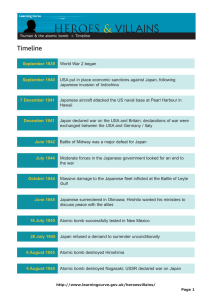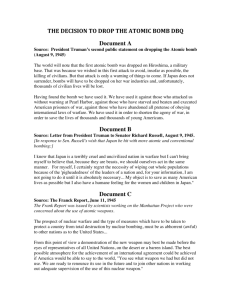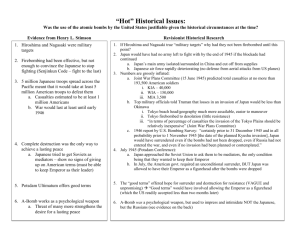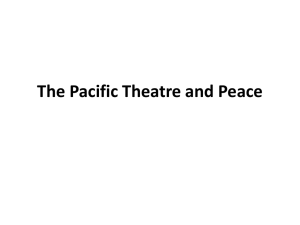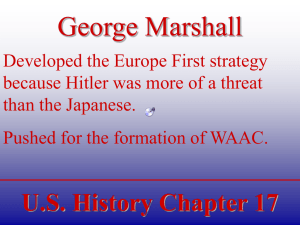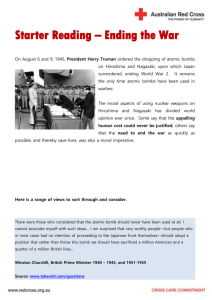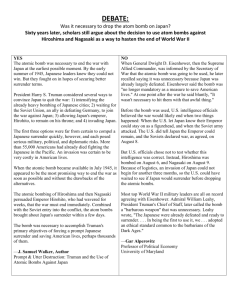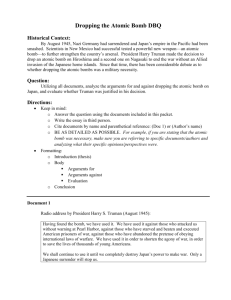American Studies
advertisement
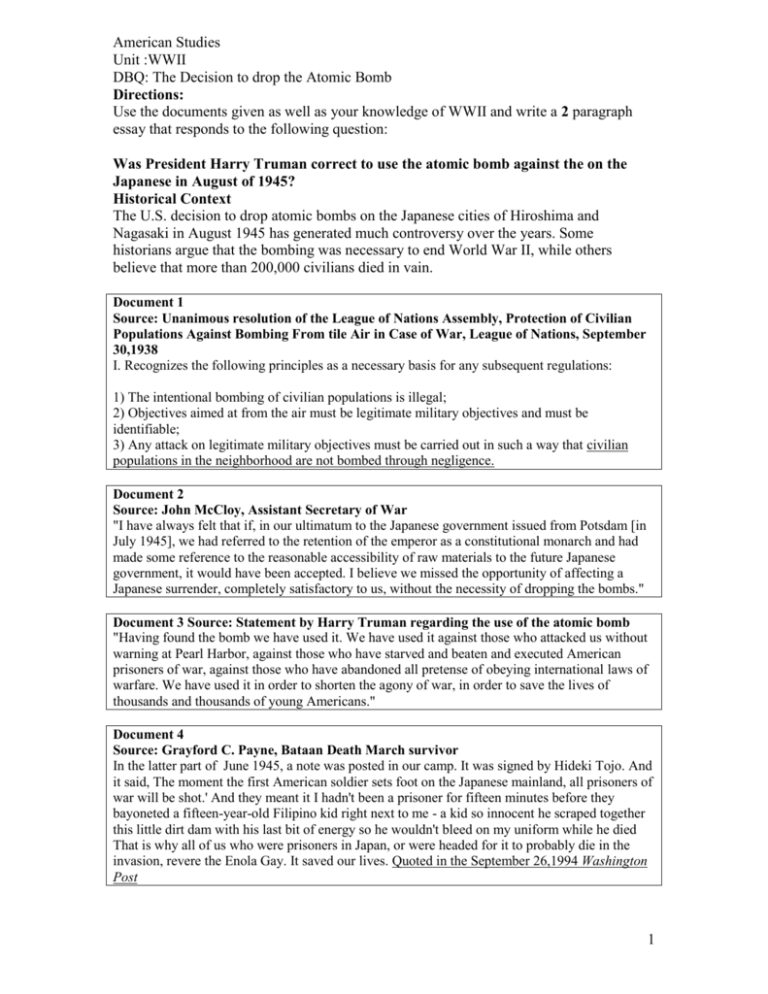
American Studies Unit :WWII DBQ: The Decision to drop the Atomic Bomb Directions: Use the documents given as well as your knowledge of WWII and write a 2 paragraph essay that responds to the following question: Was President Harry Truman correct to use the atomic bomb against the on the Japanese in August of 1945? Historical Context The U.S. decision to drop atomic bombs on the Japanese cities of Hiroshima and Nagasaki in August 1945 has generated much controversy over the years. Some historians argue that the bombing was necessary to end World War II, while others believe that more than 200,000 civilians died in vain. Document 1 Source: Unanimous resolution of the League of Nations Assembly, Protection of Civilian Populations Against Bombing From tile Air in Case of War, League of Nations, September 30,1938 I. Recognizes the following principles as a necessary basis for any subsequent regulations: 1) The intentional bombing of civilian populations is illegal; 2) Objectives aimed at from the air must be legitimate military objectives and must be identifiable; 3) Any attack on legitimate military objectives must be carried out in such a way that civilian populations in the neighborhood are not bombed through negligence. Document 2 Source: John McCloy, Assistant Secretary of War "I have always felt that if, in our ultimatum to the Japanese government issued from Potsdam [in July 1945], we had referred to the retention of the emperor as a constitutional monarch and had made some reference to the reasonable accessibility of raw materials to the future Japanese government, it would have been accepted. I believe we missed the opportunity of affecting a Japanese surrender, completely satisfactory to us, without the necessity of dropping the bombs." Document 3 Source: Statement by Harry Truman regarding the use of the atomic bomb "Having found the bomb we have used it. We have used it against those who attacked us without warning at Pearl Harbor, against those who have starved and beaten and executed American prisoners of war, against those who have abandoned all pretense of obeying international laws of warfare. We have used it in order to shorten the agony of war, in order to save the lives of thousands and thousands of young Americans." Document 4 Source: Grayford C. Payne, Bataan Death March survivor In the latter part of June 1945, a note was posted in our camp. It was signed by Hideki Tojo. And it said, The moment the first American soldier sets foot on the Japanese mainland, all prisoners of war will be shot.' And they meant it I hadn't been a prisoner for fifteen minutes before they bayoneted a fifteen-year-old Filipino kid right next to me - a kid so innocent he scraped together this little dirt dam with his last bit of energy so he wouldn't bleed on my uniform while he died That is why all of us who were prisoners in Japan, or were headed for it to probably die in the invasion, revere the Enola Gay. It saved our lives. Quoted in the September 26,1994 Washington Post 1 Document 5 Source: World War H statistics: The National Archives -June 1945 invasion of Okinawa = 49,000 American casualties -kamikaze attacks = 34 ships sunk, 368 damaged, 4,907 sailors killed, and 4,824 wounded 6,000 to 8,000 kamikaze planes would be available to oppose a Kyushu landing scheduled for 1 November 1945 -2 million Japanese troops ready to defend home islands -US Army's medical plan for Operation Olympic (invasion of Japan) estimated that total battle and non-battle casualties (not including dead) could be 394,859. Document 6 Source: Tony Atessandro, former president of the U.S.S. Missouri Association, who joined the Navy in the middle of the war at the age of 17 and "as a 19 year old kid" was present when the Japanese surrendered aboard the U.S.S. Missouri on September 2, 1945. "If we had not dropped the Atom bombs, the Japanese people would have lost 3 million people and the Allies would have lost 1 million people. You are talking about 4 million people! We saved a lot of lives by dropping them." Document 7 Source: Leo Szilard, (The first scientist to conceive of how an atomic bomb might be made in 1933) on his meeting with Truman's Sec. of State to be, James Byrnes (May 28, 1945) "Byrnes... was concerned about Russia's postwar behavior. Russian troops had moved into Hungary and Rumania, and Byrnes thought it would be very difficult to persuade Russia to withdraw her troops from these countries, that Russia might be more manageable if impressed by American military might, and that a demonstration of the bomb might impress Russia. .I was concerned at this point that by demonstrating the bomb and using it in the war against Japan, we might start an atomic arms race between America and Russia which might end with the destruction of both countries.” Document 8 Source: Admiral William E. Leahy, President Truman's Chief of Staff, in his memoirs I Was There "The use of this barbarous weapon at Hiroshima and Nagasaki was of no material assistance in our war against Japan. The Japanese were already defeated and ready to surrender... "In being the first to use it, we... adopted an ethical standard common to the barbarians of the Dark Ages. I was not taught to make war in that fashion, and wars cannot be won by destroying women and children. Document 9 Source: General Dwight D. Eisenhower, Supreme Allied Commander in Europe “I told him (Stimson, Secretary of War) I was against it on two counts. First, the Japanese were ready to surrender and it wasn’t necessary to hit them with that awful thing. Second, I hated to see our country be the first to use such a weapon.” Document 10 Source: James Franck, Professor of the University of Chicago “If the United States were to be the first to release this new means of indiscriminate destruction upon mankind, she would sacrifice public support throughout the world, precipitate the race for armaments, and prejudice the possibility of reaching an international agreement on the future control of such weapons.” 2
